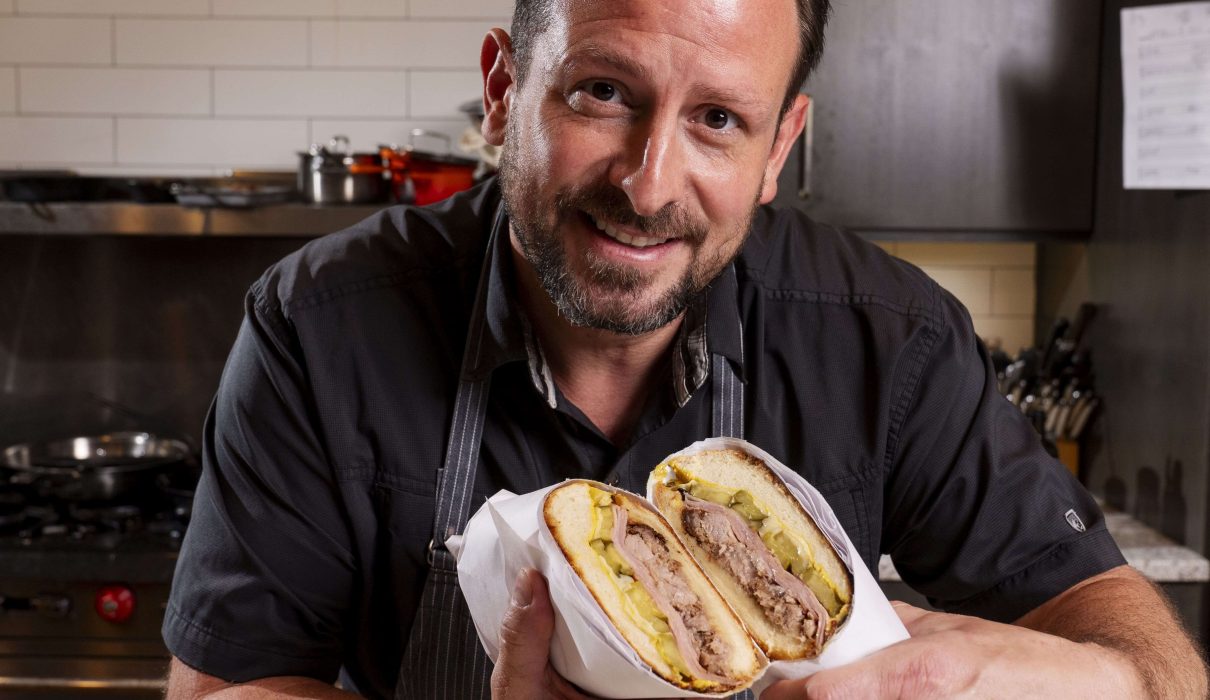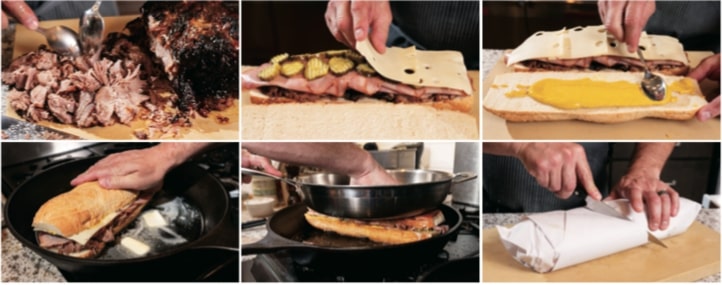Photos by L.G. Patterson
A Cuban sandwich may not be the most appealing thing, particularly if it has been smashed, griddled, wrapped and sliced. But what it lacks in eye appeal, it more than makes up for in flavor.
This south Florida variation on ham and cheese originates from Cuban immigrants working in cigar factories and sugar mills in Tampa and Key West. The sandwich was purchased by many of the Cuban workers and would need to hold up throughout the day in southern Florida heat. Mayonnaise would go bad sitting too long, but yellow mustard and pickles help the sandwich hold up until lunchtime.
The exact origin is unknown, but widely argued between the two cities. Most agree with some version coming out of Tampa, and then heading south to Miami and Key West, where it gained its popularity.
The sandwich combines many cultures with its array of ingredients. Cuban bread (a soft, yeast bread with lard invented in Tampa by a Cuban), ham (Spanish), Cuban pork, Swiss cheese, pickles and mustard (German and Jewish), and in Tampa, Genoa salami (Italian). You will have a much easier time finding this sandwich in south Florida, as opposed to Cuba.
Bread & Mustard
While traditional Cuban bread might not be widely available, you can easily find a few types of bread that may make a decent substitution. Baguettes, French bread, Italian bread or even a brioche loaf will work. You want a loaf that is not too wide, 3 to 4 inches being about the max, the length can easily be cut down.
The thickness (top to bottom) may be another issue. Too much bread is not good. I like to cut the bread lengthwise into thirds if it is too thick and remove the center (if you are making more than one, you can now have enough bread to make another sandwich). The length will be determined by how large your pan is (probably something smaller than the 15-inch cast iron pictured with this article) as you want the assembled sandwich to easily fit into the pan and not be crowded while being cooked.
The inside of the top and bottom can get a healthy slathering of yellow mustard as this will help hold the components together and give a nice tangy zip to the sandwich.
Pork
There are many types of pork that can be used; typically, pork that is left over from a roast works well. Pernil (Puerto Rican pork roast), Mojo Criollo (see recipe at end of article) or even barbecue pulled pork would work. The pork is sliced and can be reheated in its sauce or juices before being assembled. The Mojo is a traditional citrus and garlic marinade. I find it easiest to marinate a boneless or bone-in pork shoulder in a 2-gallon zip closure bag. The marinade can easily be mixed in a bowl and poured over the pork in the bag; squeeze out all of the air and marinate for six to 24 hours. I take the onions out of the marinade and place directly into the pan (kind of like a rack for the pork), then the pork, fat side up. Then pour all of the liquid with about one to two cups of water on the bottom of the pan.
Roast for three and a half to five hours, basting the pork about every 30 to 45 minutes, and add more water if the mixture starts to get too thick or has turned to mostly rendered fat. The pork will become tender when the internal temperature is about 190 degrees. Cover with a lid or plastic wrap and foil for an hour to rest. This will help the roast cool a bit but stay moist and tender.
Ham, Pickles, Salami & Cheese
You can use leftover glazed ham from a holiday, deli ham or even dry-cured ham. But the order does matter as the ham is laid on top of the sliced pork to help hold it in place.
Tampa style gets a layer of salami. The pickles go on top of the last layer of meat, then a layer of Swiss cheese, which, once pressed and melted, makes this masterpiece hold together, ready to be wrapped and travel.
Cooking & Wrapping
Once you have your sandwich assembled (bread, mustard, pork, ham, salami, pickles, cheese, mustard, bread), you are ready to griddle. Lather the top and bottom of the bread with butter, oil, bacon, fat or lard. Use a griddle, two pans, a panini press or another contraption to heat and press. Turn the heat to medium and add the sandwich, using the other pan as a weight. Keep an eye on the bottom of the sandwich, which should cook about three to six minutes until there is a medium brown crust on the bread and the cheese on top should just be starting to melt as you remove the weight and flip the sandwich. Cook for another three to six minutes until the top has a medium brown crust and the cheese is melted.
If you have achieved the crust, but still need the cheese to melt, turn off the heat and flip the pan upside down for a few minutes to let the residual heat melt the cheese. Remove the sandwich and let it rest for a minute or two, wrap in butcher paper and you are ready to go.

Mojo Criollo Pork
Ingredients
- 1 orange, juiced
- 1 grapefruit, juiced
- 1 lime, juiced
- 1 lemon, juiced
- 1 head garlic, peeled and smashed (8 to 10 cloves)
- 1/2 cup chopped fresh oregano (2 tablespoons if dried)
- 1 tsp ground cumin
- 1 onion, sliced
- 1/2 cup olive oil
- Salt and pepper for pork
- 8 to 12-pound pork shoulder
- 1 to 2 cups water to add after the marinade
Instructions
- Mix orange juice with olive oil in a bowl, stir and set aside. Place pork shoulder in a container and season heavily with salt and pepper. Place into a 2-gallon zip closure bag (you can also put it into a container, but you will need to flip every few hours to distribute marinade). Pour all of the marinade over the pork and squeeze out as much air as possible. Place into a container to prevent leakage and place into the refrigerator for six to 24 hours, flipping once or twice if possible.
- After marinating, remove the pork and marinade. In a shallow pan with a lid that will hold the pork (plastic wrap and foil can substitute a lid after cooking), place as many onions as you can under the pork with the fat side of the pork up, and add water to the marinade until liquid comes about one third up the side of the pork. Place in the oven at 300 degrees without the lid.
- Cook for 3.5 to 5 hours (basting every 30 to 45 minutes, adding more water if needed) until the internal temperature reaches 190 degrees. Remove from the oven and place on the stove or a hot pad, cover with the lid or plastic wrap, then foil and let sit for an hour.
- Transfer to a cutting board, drizzle with some of the cooking liquid and serve, or use for making Cuban sandwiches.



